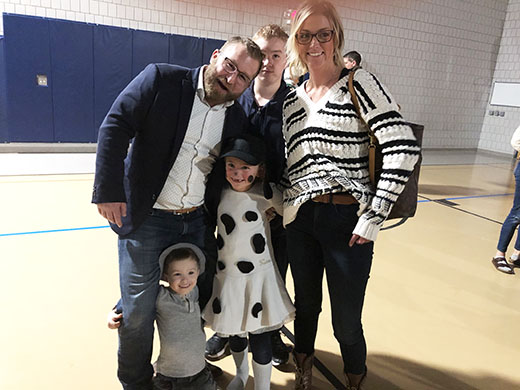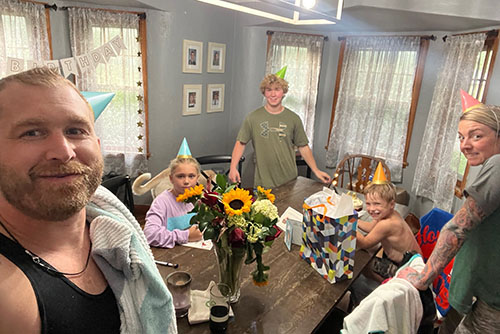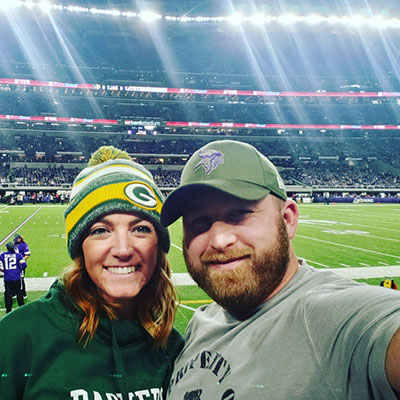Talking About Veteran Suicide is an Important Step in Prevention

Marine’s Personal Story Motivates Him to Help Others
Are you thinking about suicide?
Is that a question you would be comfortable asking someone? Is that a conversation you’re willing to have?
What if you knew that question could be the difference between life or death?
Recent research has shown that more post-9/11 veterans have died from suicide than in combat. According to WWP’s 2021 Annual Warrior Survey, nearly 1 in 4 warriors served by Wounded Warrior Project® (WWP) had suicidal thoughts in the past 12 months, with 70% having them in the previous two weeks. The report also shows 16% of WWP warriors have attempted suicide at least once in their lifetimes, and the average number of suicide attempts doubled after military service.
The reasons for these numbers vary, but destigmatizing seeking mental health care could go a long way in reducing veteran suicide.
The traditional military mentality is focus on the task at hand. For many post-9/11 service members, these tasks involved death, physical pain, traumatic brain injury (TBI), and post-traumatic stress disorder (PTSD). “Suck it up and drive on” is an often-repeated phrase in the military. Difficulty navigating resources, struggling to find mental health services, or fears of negative perceptions of seeking mental health care could further contribute to the problem.
When warriors return home, everything looks and feels different. They’re often separated from their brothers and sisters in arms who understand their plight, and are reliving the sounds, smells, and thoughts of war, while trying to figure out their next step.
Being able to “suck it up” may serve military members well during combat, but it’s important for warriors to know it’s just as acceptable to seek help for the invisible wounds of war as it is for the physical ones.
“It’s OK to not be OK,” said U.S. Marine veteran Dan Hanson, who is also an outreach specialist for Wounded Warrior Project® (WWP).
Coming Out of the Dark to Help Shine a Light for Others
Dan is an instructor of Applied Suicide Intervention Skills Training (ASIST), a two-day workshop that is conducted across the country and facilitated by WWP. The workshops help participants learn how to talk to someone about suicide, the warning signs to watch for, and how to develop a plan to react immediately to a crisis.
Learn more about ASIST
Suicide prevention is particularly personal to Dan. His brother Travis, a fellow Marine, died by suicide, contributing to a downward spiral for Dan. He struggled with substance use and his constant thoughts of suicide culminated in attempting to take his own life. Dan and his siblings have an impressive history of military service but talking about the effects of that service wasn’t commonplace. Dan, like his brother, struggled in silence for a long time until a pivotal event in his life helped him realize he and his family deserved better – and so do other veterans.

“It almost crushed me for a while, after my brother killed himself,” Dan said. “I was lifeless. I was angry every single day. I got to a point where I said, ‘I can't let this eat me up anymore.’ Instead of having this be my biggest weakness, I'm going to turn it into a strength and it's going to be to save other people who are struggling.”
According to the Department of Veterans Affairs’ 2021 National Veteran Suicide Prevention Report, nearly 46,000 people died by suicide in the U.S. in 2019 (the most recent year recorded in the report). Veterans are even more at risk. The report shows the unadjusted suicide rate among nonveteran U.S. adults was to 16.8 per 100,000 in 2019. In comparison, the rate among veterans was 31.6 per 100,000 the same year, meaning veterans were almost twice as likely to die by suicide than nonveterans.
Dan is determined to reduce those numbers and help other veterans find their way out of the darkness, like he did.
“For me, it's motivation. I think that's why I've taught so many classes,” he said. “That's why, when I'm given the opportunity to do anything to reduce that stigma, to educate people on suicide, that's what I'm going to do.”
Building a Connection and Getting Help
According to the most recent U.S. Census numbers (2020), military veterans account for less than 7% of the U.S. population, and research shows that number is likely to decline with fewer people enlisting in the all-volunteer military.
Once service members leave the military and reenter the civilian world, that connection is often lost. WWP’s 2021 Annual Warrior Survey shows loneliness is a big issue for many of the warriors (62%) surveyed, and that PTSD symptoms are reduced for warriors who maintain social support with military friends.

There’s also the sense of not fitting in the current environment as a civilian and not serving others in the same way. That mindset can make transitioning from the military particularly difficult for some.
“I think that's a big piece of it, the loss of identity, so what a lot of people feel is a de-escalated sense of purpose. I think it really, really affects individuals,” Dan said. “I think you feel like you're on an island, a lot of the times, and most people in your life can't relate to situations like that. Then you struggle with maybe some of the PTSD or depression or the anxiety, and then that drives a further wedge between you and other people, and again you go back to withdrawing and feeling disengaged.”
Wounded Warrior Project aims to help warriors build the connection with other veterans through peer support and alumni events. WWP also has free mental health programs designed to help warriors improve their mental well-being and build stronger relationships with their family members and caregivers.
The most important thing, however, is that warriors know they’re not alone, there’s no shame in seeking help and that they deserve to better their lives – for themselves and their families.
“I think talking about it and giving them a forum to talk about it, as well as having programs and services that focus on mental health, is the best way to combat [the problem],” Dan said. “We just have to normalize it. So, I think that's the biggest thing – just starting the conversation and keeping it going.”
If you or someone you know is struggling with thoughts of suicide, contact the Veterans Crisis Line by dialing 988 (press 1), or texting 838255
Contact: — Paris Moulden, Public Relations, pmoulden@woundedwarriorproject.org, 904.570.7910
About Wounded Warrior Project
Since 2003, Wounded Warrior Project® (WWP) has been meeting the growing needs of warriors, their families, and caregivers — helping them achieve their highest ambition. Learn more.